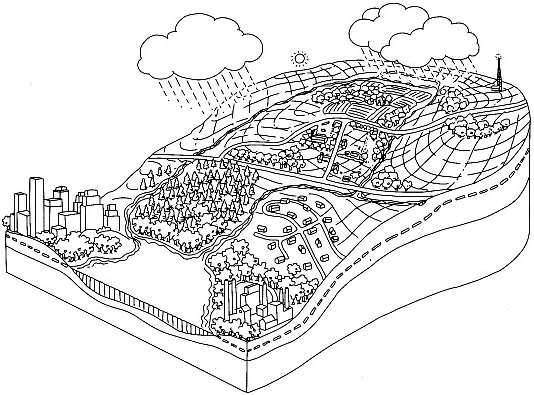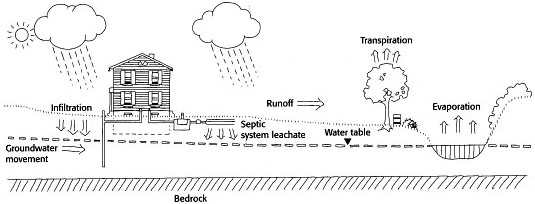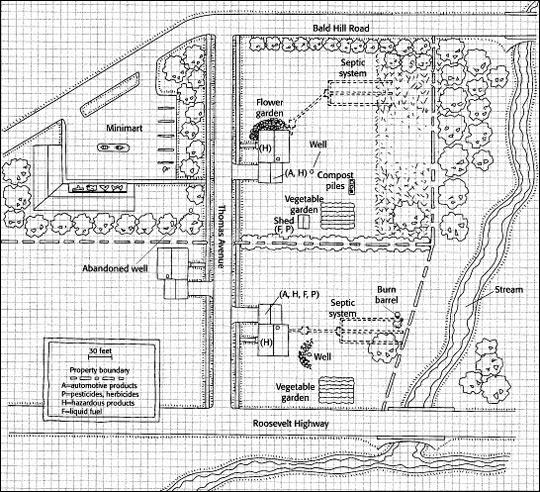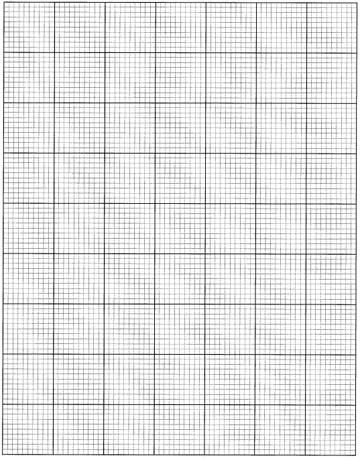Fact sheet 1
Missouri's geology is diverse. A home in north Missouri will almost certainly have different characteristics — and present different environmental risks — than a home in the Ozarks. The porous limestone (karst) areas of southern Missouri present dangers to groundwater supplies through practices on the farm and home. The tight clay soils of northern Missouri may not allow pollutants to enter groundwater, but increase the risk to surface waters — waters that most northern Missourians rely on for a safe drinking water supply.
Is your soil sandy or gravelly? Does it drain quickly? Does storm water runoff from your property flow into a nearby lake or pond? Do you store hazardous chemicals on your homesite, and are they close to a well or next to a lake, stream, or river? This guide will help you become familiar with your homesite and how you manage it so you can identify risks to water resources. Completing the work sheet and site map will provide background information you can use as you complete other work sheets in this program.
This guide covers two areas
- Physical characteristics of your homesite
Examples of characteristics include soil type and depth; depth to bedrock; depth to the water table; and location of wetlands, streams, or other surface water. - Making a map of your homesite
A map of your homesite showing buildings, roads and other constructed or natural features can help you identify potential sources of trouble.
Why should you examine your homesite's physical characteristics and how you manage your home?
What you do in and around your home can affect water quality below the soil surface and in nearby lakes, streams, wetlands or coastal ponds. This section will help you identify some important characteristics of your homesite such as soil type, geology, depth to groundwater, and nearness to surface water.
It also invites you to draw a simple "aerial view" map of your homesite. Your completed map will show the locations of important features and help you identify activities in and around your home that may pose risks to your health and the environment.
Remember, this assessment is a starting point. It is meant to encourage you to complete some, or all, of the work sheets in this program.
The following list of common practices should help you to begin thinking about how your activities and site conditions can affect water quality:
- Washing spilled motor oil and grass clippings into storm drains or surface waters.
- Storing gasoline and other hazardous chemicals near children's toys.
- Paving walkways instead of using porous material, thus increasing runoff.
- Not separating garbage for recycling.
- Placing sprinklers so the water runs onto a sidewalk or street.
- Planting flowers and other vegetation that may require fertilizers and pesticides near a wellhead.
- Burning garbage, which may add toxins to air that eventually settle on the ground surface.
What is a watershed?
The water from your tap and in nearby lakes or streams is part of a much larger water system. While not everyone lives next to a pond or stream, we all live in a watershed — the land area that contributes water to a specific surface water body, such as a pond, lake, wetland or river. The landscape's hills and valleys define the watershed, or "catchment" area.
A watershed is like a bathtub. The watershed outlet — the mouth of a pond, lake or river — is the tub's drain.
The watershed boundary is the tub's rim. The watershed's drainage system consists of a network of rivers, streams, constructed channels and storm drains, wetlands, and the underlying groundwater.
Common activities, such as driving your car or fertilizing your lawn and garden, can affect water quality — even when you do these things far from any body of water. By paying careful attention to how you manage activities in and around your home, you can protect your watershed and the water you drink.

Figure 1.1
A watershed. Activities in the watershed can affect groundwater, stream and lake quality at lower elevations in the watershed.
What influences the quality of my water?
Understanding the site characteristics of your residence and the location of potential contamination sources are important first steps in safeguarding your water. In the hydrologic cycle, water moves through the air, over land, and through the soil (Figure 1.2).
Physical characteristics, such as soil type, depth to groundwater and distance to surface water, may increase or limit a contaminant's effect on water quality.
Water quality is also affected by drinking-water well construction and maintenance, pesticide and fertilizer use and storage, septic system location and maintenance, waste disposal methods, and soil erosion.
Animal wastes are another threat to water quality, particularly if large amounts of manures from horses, dogs or other animals are allowed to accumulate on your property. To protect your water, all of these factors should be considered.

Figure 1.2
In the hydrologic cycle, water falls to the earth as rainfall and snow and returns to the atmosphere through transpiration and evaporation.
Site Assessment: Part 1
Physical characteristics of your homesite
Every home comes with its own unique set of physical site conditions. You cannot change these conditions, but once you are aware of them, you can better understand risks that may result from activities you can change. The information below will help you answer the work sheet questions.
How can soil type affect water quality?
Soil plays an important role in determining where contaminants go and how water moves. Nearly all soils are permeable, which means water and other fluids can percolate, or seep, through them. Different soils have different properties that permit water (and contaminants) to percolate through the soil or run off at variable rates.
Lawn chemicals and leachate from a leaking septic tank, for example, can flow downward into groundwater or across the land into surface water. Many household activities can also produce problems that go beyond property boundaries. For example, contaminants that enter groundwater through a neighbor's abandoned well may flow underground until they reach your well.
What is your soil type?
Soil is grouped into three basic types based on particle size:
- Clay
Which has small particles; - Silt/loam
Which has medium particles; - Sand/gravel
Which has large particles.
You can get a good idea about your soil type by rubbing a moistened sample between two fingers. Is it sticky like clay, gritty and crumbly like sand, or somewhere in between like loam?
Soil tests will provide information on soil type. For information on taking a soil test, contact your local MU Extension centers, the Soil and Water Conservation District or local Natural Resource Conservation Service offices.
How does soil type affect groundwater?
Groundwater is the water below the surface of the earth that, from the water table down, saturates the spaces between soil particles, sand and gravel layers, or fills cracks in underlying bedrock.
Soil particle size influences which pollutants are able to reach groundwater. Some soils are better at trapping pollutants than others. Clay soils, common in north Missouri, are made of tiny particles, so they slow the downward movement of water and sometimes impede water movement completely. Sandy soils, as found in the Missouri Bootheel and along large rivers, allow rapid water movement, and silty soils occupy the middle range.
Soils made of large particles pose the greatest risk, because water seeps downward through them readily without filtering out or decomposing pollutants.
The ideal soil is a mix of midsize particles to allow infiltration and tiny particles, like clay or organic matter, to slow water movement and filter pollutants.
What are the risks to surface water?
Soil type can also affect surface water contamination. Although runoff occurs from all soil types, clay soils are more likely to cause surface water runoff because they are less permeable.
During a storm or flood, or even when watering your lawn, this runoff can wash contaminants from the land's surface into nearby surface waters. Eroding soil is also considered a water pollutant. Bare soil, especially on sloping land, can run off into streams, rivers, lakes or estuaries.
What is your soil depth?
The depth of soil influences risks to groundwater. Usually, the greater your soil depth, the farther water must seep down before reaching groundwater. Deep soils offer a better chance of filtering or breaking down pollutants before they reach groundwater.
Generally, soils that are less than three feet deep present the highest risks for groundwater contamination.
How far down to reach bedrock?
Bedrock depth varies; it can be at the surface, just below the surface or hundreds of feet down. The type of bedrock influences pollution risks. Shale, granites, and other impermeable types of rock make an effective barrier that blocks the downward movement of water and contaminants.
Other rocks, such as limestone, can be highly permeable, allowing water to move freely into groundwater. When bedrock is split or fractured, water can move through it unpredictably, spreading pollutants rapidly over long distances.
How deep is the water table?
If you dig a hole, you will eventually reach soil saturated with water. This water table marks the boundary between the unsaturated soil (where pore spaces between soil or rock contain air, roots, soil organisms and some water) and the saturated soil, or groundwater (where water fills all pore spaces). In a wetland, the water table is at or just below the surface.
Your local water table fluctuates throughout the year but is usually highest in the wet months of spring and in late fall. In general, the closer the water table is to the land's surface, the more the groundwater is susceptible to contamination. Usually, a water table that is less than ten feet from the surface presents a higher risk for groundwater contamination.
How can you find out what is going on underground?
There are several ways to find out about soil depth, bedrock type and other features below the ground. Check your well-drilling records (if you have them), ask a neighbor who has a well, call a local well-drilling company, talk to your county MU Extension specialist, or call the local government office that gives permits for drilling wells (Division of Geology and Land Survey of the Missouri Department of Natural Resources, in Rolla, Mo., 573-368-2190.
The Natural Resources Conservation Service maintains county soil surveys. The U.S. Geological Survey maintains groundwater maps.
Groundwater and surface water are interconnected. Groundwater generally flows downhill, following the same path as surface water, and eventually discharges into rivers, lakes, springs, wetlands, bays or estuaries. If you keep impurities out of surface water but do not protect groundwater — or vice versa — contaminated waters may occur where you least expect.
Site Assessment: Part 2
Making a map of your homesite
By drawing a map of your homesite, you will take another step toward more fully understanding your pollution risks. Although your property has physical features you cannot change, there are many things that you can do to minimize risks.
Your map will identify areas where you can focus your efforts. It will also assist you as you complete the other work sheets in this pollution prevention program.
And if you involve children as you make your map and conduct the assessment, you will help teach them the importance of having clean water.
These are the materials you need to make your map: a measuring tape, a clipboard, a pencil and the grid provided below. The map you create will be an aerial view — the way your property would look if you took a photo of it from the air. See Figure 1.3 to view a sample map.

Figure 1.3
Sample homesite map.
 Graph Paper for Homesite Map
Graph Paper for Homesite Map
One block = 1/10 inch = 10 feet.
Potential sources of contaminants
Several home management practices and home site characteristics could have major effects on water quality.
As you survey your property to make your map, be especially watchful for the following:
- Improperly located or poorly maintained septic system or sewage lagoon;
- Pipes that discharge sewage to the surface;
- Underground or aboveground storage tank containing fuel oil, gasoline, or other petroleum products;
- Improperly constructed or abandoned well;
- Stockpiled animal manures or animal pens, corrals or kennels close to a well or surface water body;
- Improper storage, use or disposal of yard and garden chemicals and other hazardous products like paints and solvents;
- Machine maintenance workshop near well;
- Road de-icing materials (salt, cinders) that flow toward a well or nearby surface water body
Instructions for your homesite map
Homesite features to include
- Property boundaries
- House and garage
- Outbuildings, sheds
- Septic system, drain field
- Nearest surface water
- Water wells
- Dry or abandoned wells
- Heating oil or other fuel
- Storage tanks
- Building perimeter drains
- Lawn areas
- Vegetable and flower gardens
- Other cultivated areas
- Animal manure storage areas
- Roads, driveways
- Drainage ditches
- Impervious surfaces (such as patios or sidewalks)
- Refuse piles or storage
- Drainage swales and gullies
Location codes
On your map, note the areas where you store and use chemicals and other potential hazards by using letter codes. Make up your own code letters or symbols as needed.
Examples are
- F = Fuel tanks for gasoline or heating oil
- A = Automotive products like motor oil, gasoline and antifreeze
- P = Pesticides, herbicides
- H = Hazardous products like solvents, acids, paints and thinners
Other map-making ideas
For larger-view maps, add landscape features such as hills, rivers and ponds and human-built features such as runoff drainways, roads and bridges.
Note potential sources of contamination beyond the boundaries of your property such as farm fields, dumps and gas stations. Indicate seasonal changes at your homesite.
For example, are there wet areas in the spring? Such areas might indicate a high water table.
Don't leave out things you cannot see
Inquire about previous or current industrial or agricultural activities in the area. Check with your town or city hall for information. Old landfills and buried fuel tanks are just a few examples of what you might find.
Determine if any underground fuel tanks exist on neighboring properties. If there are tanks, septic systems, or other potential sources of contaminants uphill from your well, they could affect the safety of your groundwater. These issues will be discussed in depth in subsequent chapters.
Taking action
The final step is to put both pieces of your assessment together — the work sheet results and map — so you can identify potential problem areas on your property. If you have rated any of the items in the table as medium or high risks and have identified potential contamination sources, then you should be concerned.
For example, you may have identified an underground heating oil tank or realized that you apply lawn or garden chemicals within 25 feet of a lake or stream. Perhaps your soil is sandy or your gasoline storage tank is close to your drinking water well. Is there an old abandoned well on your property that isn't properly sealed? To protect your family's health and the environment, and to safeguard your financial investment, you will want to take steps to correct these problems.